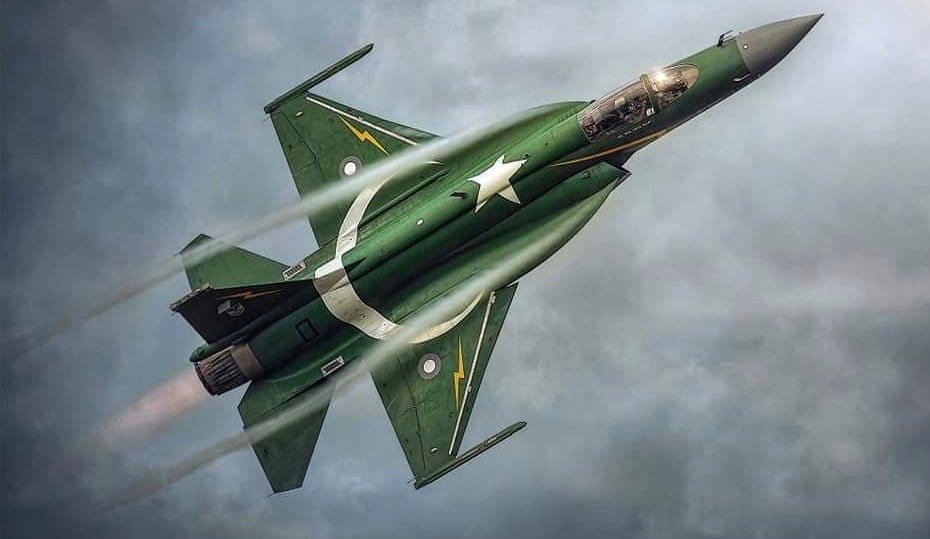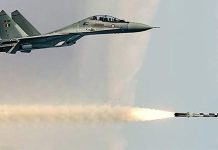JF-17 Thunder is a 4th generation light fighter aircraft developed jointly by China and Pakistan. Promoted with many preeminent features and very cheap prices, but so far, this fighter is still in a slump.
According to Pakistani military sources, the Pakistan Air Force used JF-17 fighters to shoot down Indian planes in February 2019. As soon as the Indian aircraft crossed the Line of Control, JF-17 fighter immediately appeared and performed its mission. Although it was not revealed what weapon JF-17 used to intercept, the Pakistan Air Force announced it had shot down both the Indian MiG-21 Bison and Mi-17 helicopter. The success of the JF-17 Thunder in the first real combat by shooting down the MiG-21 Bison caused observers to speculate that the gloomy market of this aircraft will end.
The JF-17 Thunder or FC-1 Xiaolong, is a lightweight, single-engine, multi-role combat aircraft developed jointly by the Pakistan Aeronautical Complex and the Chengdu Aircraft Corporation of China. The JF-17 can be used for aerial reconnaissance, ground attack and aircraft interception. Its designation “JF-17” by Pakistan is short for “Joint Fighter-17”, while the designation and name “FC-1 Xiaolong” by China means “Fighter China-1 Fierce Dragon”.
The JF-17 was primarily developed to meet the Pakistan Air Force requirement for an affordable,[16] modern, multi-role combat aircraft as a replacement for its large fleet of Dassault Mirage III fighters, Nanchang A-5 bombers, and Chengdu F-7 interceptors. For China, JF-17 “Thunder” multirole fighter is one of country’s most successful aerospace exports, has the potential to be a cost-effective and competitive alternative to more expensive Western fighters.

By 1989, because of economic sanctions by the US, Pakistan had abandoned Project Sabre II, a design study involving US aircraft manufacturer Grumman and China, and had decided to redesign and upgrade the Chengdu F-7. In the same year, China and Grumman started a new design study to develop the Super 7, another redesigned Chengdu F-7.
Grumman pulled out of the Super 7 project in 1989 due to Tiananmen Square and the resulting fallout. The project remained on ice for around 10 years as negotiations between China and Pakistan continued. A feasibility study to see if future development would be fruitful was commissioned in 1992, it was successful so a memorandum to continue development was signed.

In 1998 China and Pakistan recommenced serious development of the Super 7. Costs were split 50/50 between the Pakistani government and CAC and the aircraft was renamed JF-17. As Grumman had dropped out, the fighter needed a new powerplant. A solution was found in the Russian Mikoyan design bureau, which offered the Klimov RD-93 engine which was originally designed for the canceled MiG-33 fighter jet. The RD-93 was an advanced version of the RD-33 used on the MiG-29, however, only one RD-93 is used on the JF-17 in contrast to two RD-33s in a MiG-29.

Another key innovation that occurred during the development process was the inclusion of diverterless supersonic intakes on the JF-17 design. The design went through several iterations but is seen on current JF-17 production aircraft. In 2003 the first prototype took to the air. By 2006 the JF-17 was finalized and ready to enter serial production. It was formally adopted in 2007. The first fully Pakistani-manufactured JF-17 was created in 2008.
The air frame is of semi-monocoque structure constructed primarily of aluminum alloys. High strength steel and titanium alloys are partially adopted in some critical areas. The air frame is designed for a service life of 4,000 flight hours or 25 years, the first overhaul being due at 1,200 flight hours.

The retractable undercarriage has a tricycle arrangement with a single steerable nose-wheel and two main undercarriages. The hydraulic brakes have an automatic anti-skid system.
The mid-mounted wings are of cropped-delta configuration. Near the wing root are the leading-edge root extension, which generate a vortex that provides extra lift to the wing at high angles of attack encountered during combat maneuvers. A conventional tri-plane empennage arrangement is incorporated, with all-moving stabilators, single vertical stabiliser, rudder, and twin ventral fins.

The glass cockpit is covered by a transparent, acrylic canopy that provides the pilot with a good, all-round field of view. It has three large Multifunction Colour Displays and smart Heads-Up Display with built-in symbol generation capability. A centre stick is used for pitch and roll control while rudder pedals control yaw. A throttle is located to the left of the pilot. The cockpit incorporates hands-on-throttle-and-stick controls. The pilot sits on a Martin-Baker Mk-16LE zero-zero ejection seat. The cockpit incorporates an electronic flight instrument system and a wide-angle, holographic head-up display, which has a minimum total field of view of 25 degrees.
As mentioned above, JF-17 is equipped with a Klimov RD-93 Afterburning Turbofan, creating a dry thrust of 11,105lb and 19,180lb thrust with afterburner, making the aircraft can fly at a maximum speed of Mach 1.6. The range and service ceiling of the aircraft are 2,037km and 15,240m, respectively. Its operational radius is 1,352km. The aircraft weighs around 6,411kg and its maximum take-off weight is 12,474kg.

The JF-17 can be armed with up to 3,700 kg of air-to-air and air-to-ground weaponry, and other equipment mounted externally on the aircraft’s seven hardpoints. One hardpoint is located under the fuselage between the main landing gear, two are underneath each wing, and one is at each wing-tip.
Internal armament comprises one 23mm GSh-23-2 twin-barrel cannon mounted under the port side air intake, which can be replaced with a 30mm GSh-30-2 twin-barrel cannon.

The aircraft is fitted with PL-12 or SD-10 radar homing medium-range air-to-air missile, unguided bombs, satellite guided bombs, gravity bombs, anti-ship missiles, anti-radiation missiles, rocket launchers and a laser designator pod. The JF-17 is equipped with AIM-9L, PL-5E, PL-9C short range air-to-air missiles on its wingtip hardpoints.
Read more:
- CASA C-295 – The transport aircraft has gained a solid position in the world aircraft market
- KAI KF-X – The South Korean self-developed stealth fighter
- F-16I Sufa – The most modern F-16 fighter version of the Israeli Air Force
The JF-17’s designers have proven adept at keeping up with the times following its entry into service. The initial run of fighters for Pakistan have been referred to as Block I JF-17s. Block II JF-17s introduced a multitude of new capabilities and upgrades, including composites in the airframe for reduced weight, air to air refueling, a full fly-by-wire system, and a better radar. China offered to replace the Russian RD-93s with their own WS-13 in Block II JF-17s, but Pakistan opted to stick with the Russian engine.

For the Block III, China hopes to add an AESA radar to the JF-17 and further improve the avionics and weapons compatibility of the JF-17. The standard JF-17 features the MIL-STD-1760 databus in some implementations, allowing for compatibility with Western and Eastern weapons. The largest advantage of the JF-17 is its cost. At only 15 million per plane in its most basic configuration, the JF-17 is far cheaper than any of its competitors, even used.

Block II JF-17s cost around the same margin, with Myanmar buying them for only 16 million per unit. This has been the key to the JF-17’s export success. A poor nation can field a relatively modern fighter for a very low price. It is yet to be seen whether it can actually perform at its price point in combat, but Pakistan seems to be satisfied with what the JF-17 can do in trials. In many ways, China has updated the budget fighter of the last generation, the MiG-21, for the modern era with the help and additional design cues from the F-16.






















